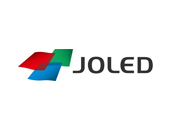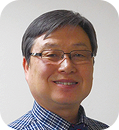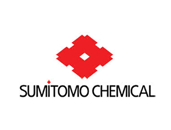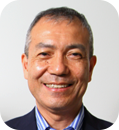2018 Speaker Announcement
View from Panel Makers about OLED Market

Dr. Chang Wook Han
Department Leader(Chief Research Fellow) of OLED Device Technology Department of LG Display
Title: OLED Will Change Your Lifestyle!


Dr. BongHyun You
Vice President of Samsung Display
Title: Next Generation OLED Display Application and Latest Technology Trend


Dr. Chenggong Wang
Project Director of the Institute of
Advanced Display Technology in Visionox
Title: Flexible AMOLED, Opportunities and Challenges in Display Industry

Abstract : Recently, the flexible AMOLED display has attracted a lot of attentions and people thought it is one of the strongest candidates for the next generation display technology. In this presentation, I will review the history of the AMOLED and flexible AMOLED.I will state the opportunities and challenges in AMOLED display. I will also present the latest R&D progress of flexible AMOLED in Visionox. Finally, I will give a brief introduction about the Visionox and our expansion plan in the next three years.

Dr. James Lee
Deputy Chief Engineer of Advanced Display Technology of TCL Corporate Research
Title: Printing OLED Technology for TV Application: Opportunities & Challenges

Abstract :
1. Premium TV Market & Technology Trend
2. What’s Key Success Factors for Commercialization of Next Generation Premium TV?
3. TCL OLED Technology Development Update
(1) Why Printing Technology?
(2) What’s Technical Challenges & Latest Breakthrough of OLED Printing Technology?
4. TCL Platform OLED Technology Development Strategy
5. Summary

Dr. Toshiaki Arai
Chief Technologist of JOLED
Title: Dawn of Printed OLED Display Manufacturing

Abstract : The OLED came to attract attention as various information displays. JOLED started the production of middle-sized printed OLED display. We hope our RGB printing method brings an innovation for the display manufacturing and a dawn of the new display era.
Vision and Idea about Future Applications

Yoshihiro ono
General Manager of Product Development Department of Sony Visual Product Inc.
Title: Designs for BRAVIA OLED TV and Expectations for large screen OLED devices.

Abstract : I will explain how we designed BRAVIA OLED™ TV and tell expectations for future large screen OLED devices from TV set manufacturer point of view

Dr. Julian Chang
Associate Tech Fellow of Boeing Commercial Airplane
Title: Blue Skies and Stars – Future Airplane Cabin Innovation


Dr. Joel S Kollin
Director of Hardware Engineering of Microsoft Research
Title: OLEDs for Near-Eye Display

Abstract : OLED panels present both opportunities and challenges for HMD and other near-eye display applications. I will discuss some of more interesting use cases and a wish list of the capabilities that optical systems engineers need to make them happen.
Opinions from Business and Industry Analysts

Dr. Choong Hoon Yi
Chief Analyst/President of UBI Research
Title: 2018 OLED Market Preview

Abstract : The flexible OLED market, which had been expected to grow rapidly due to the adoption of flexible OLEDs in iPhone X, is cooling down due to sluggish iPhone X sales. The sluggish iPhone X sales of more than $1,000 may affect the foldable OLED smartphone, which is expected to be released at the end of the year. LG Display, which produces OLEDs for TVs, is asking for panel price hikes to escape the continuous loss. UBI Research will analyze the various factors that affect OLED industry growth and forecast future OLED market.

Dr. Yasuo Nakane
Global Head of Technology Research/
Senior Analyst of Mizuho Securities Co., Ltd.
Title: View on the Display Supply Chain Outlook

Abstract : To improve yields of their OLED devices, display manufacturers utilize a demura process which requires highly accurate and high-resolution luminance measurements. This paper presents results from a system consisting of two imaging photometers to maximize measurement accuracy and resolution.

Dr. Zine Bouhamri
Technology & Market Analyst-Display of Yole Développement
Title: Emerging Technologies and alternative to OLED

Abstract : Development of new display technologies is mostly related to the high-end TV market, on which competition is currently raging between OLED- and Quantum Dot-based TV makers. The recent presentation of Samsung’s The Wall may now also bring MicroLED technology into this competition, with more and more players working on this emerging technology. During this talk, we will present these different display technologies and how their industrial landscapes look like, and then compare their status and prospects on major applications to see how they might impact the OLED field.

Hyuncheol Soh
Head of Equity Display Sector Research Center of SHINHAN INVESTMENT
Title: Revolution of OLED

Abstract :
1. Resurrection of Sony
2. Success of LGE OLED TV
3. Strategy of LG Display OLED TV
4. Supply and Demand of LCD panel in 2018
5. Autonomous Car and Display industry
6. Popularization of OLED Smartphone and OLED new devices
Solution Process Technology, yet to come

Dr. Michael Hack
Vice President of Business Development of UDC
Tilte: Organic Vapor Jet Printing: a new printing technology for large area OLED displays

Abstract : Organic Vapor Jet Printing (OVJP) is a solvent-less, mask-less printing technology for depositing patterned small molecule organic materials to manufacture large area side by side R-G-B OLED displays.
Commercial manufacture of large area (TV), side-by-side RGB OLED displays is currently challenged by lack of a suitable methodology for the patterned OLED deposition. Fine metal masks used for mobile OLED displays have not been proven to scale to greater than Gen 8, and scanning smaller shadow masks across a large area has not provided acceptable yield. Inkjet technology has been in development for many years and has yet to provide sufficient performance for volume manufacturing. Organic Vapor Jet Printing (OVJP) has been developed to print patterned OLED layers for large area displays, while avoiding issues arising from the use of fine metal masks and use of solvents.

Dr. Rémi ANEMIAN
Head of Global Technical Marketing OLED of Merck
Title: OLEDs state-of-the-art materials: Merck development and latest status


Dr. Jeff Hebb
Vice President of Kateeva
Title: Advanced Inkjet Printing for OLED displays

Abstract : The OLED revolution is already well underway in the smartphone market, enabling new form factors, all screen displays, and thinner, lighter displays. The size of the worldwide OLED display market is expected to increase from $23.2 billion in 2017 to $62.8 billion in 2022, representing a five-year compound annual growth rate of 22.0% (DSCC, SID 2017). But the OLED revolution is just getting started. In the next decade, we expect that OLED technology will enable products which feature foldable and rollable displays, as well as large displays (TVs, signs) with superb contrast and color.
Advanced inkjet printing (IJP) is already playing a critical role in today’s OLED products. Inkjet deposition printing has emerged as the leading deposition method currently operating for mass production of the organic TFE layer of mobile OLED displays. For the TFE process, IJP provided numerous technical and cost advantages over alternate organic film deposition techniques. Looking forward, IJP will continue to play a critical role in enabling the next two inflections in the OLED technology roadmap. For smartphone technology, we believe the next inflection is the foldable display, which will require improved TFE processes to achieve the lifetimes and yields required for mass production. Extending the current TFE process, including IJP for the critical organic interlayer, is the most likely path forward to meet the requirements of foldable displays.
We believe the next inflection in the TV technology roadmap is the mass production of RGB OLED TVs, which cannot be manufactured at low cost using conventional pixel patterning techniques used on small area displays. Advanced IJP is a promising candidate for cost-effective pixel patterning, and multiple display manufacturers are already doing evaluation of RGB IJP technology in their R&D lines.
This presentation will address the application of Kateeva’s advanced IJP technology to the manufacturing of current and future OLED displays.

Yamada Takeshi
General Manager of PLED Business Planning Office of SUMITOMO CHEMICAL CO., LTD.
Title: Printed Device Performance and its Fundamentals for Polymer-OLED Materials

Abstract : We will present the latest status of high performance OLED material development based on our conjugated polymer technology. We also show the comparison of the performance between ink-jet (IJ) and spin devices, and its theoretical fundamentals to obtain high performance in IJ printing.
New Performance Development from Major SCMs

Dr. Chung-Seock Kang
Vice President of Kolon Industries Inc.
Title: Applications of Transparent Polymide for Flexible Electronics.

Abstract : Polyimide(PI) has know to have wonderful mechanical and thermal properties. Thanks to those excellent properties, PIs have been believed to be a strong candidate for glass substrate replacement for displays. PI already has been used as a plastic substrate for AMOLED smartphone and watch. However, they have a limitation to broaden their application area in display field mainly due to their dark brown color.
We, KOLON, have been developing transparent, colorless PI(CPI tm) for the applications of flexible electronics. In this talk, some typical applications of CPI tm and its advantages over the conventional materials used in those applications will be introduced.

David Flattery
Global Business Manager of DuPont
Title: Advanced Materials for Printed OLEDs and Flexible Substrates


Dr. Christopher J. Campbell
Adhesives Technology Manager of
Display Materials & System Division of 3M
Title: Optically Clear Adhesives Enabling Flexible and Foldable OLED Displays

Abstract : Optically clear adhesives (OCA) have been used for more than a decade to bond rigid LCD and AMOLED displays for consumer electronics applications, offering optical, mechanical and electrical performance benefits. The performance requirements of an OCA to bond cover window, touch sensors, and circular polarizers in a plastic OLED display to bent coverglass or a flexible, foldable OLED display are drastically different from a flat, rigid device.

InGui Park
Korea Technology Center Leader of Momentive
Title: The Advantage of Silicone Buffer Coat Ink to Thin Film Encapsulation

Abstract :Thin-film encapsulation(TFE) using the Vitex multilayer technology with the implementation of three or less dyads is one of the most potent methods to ensure for protection from moisture and Oxygen penetration in OLED Devices. This is the origin to start Ink material applied to the organic layers as a proven evidence of Vitex System.
However, OLED thin film encapsulation technology is the one of technologies emerging as the core technology of flexible OLED, and More of Ink technology development & Solutions are required from conventional organic Ink base such as Flexibility, Dimensional Stability, High purity with low outgas generation. This brings Silicone nature to be candidate as a reliable TFE structure.
In this presentation, Momentive’s patented InvisiSil® AM2046series offers high performance with high reliable Silicone base Ink material solution for Flexible OLED TFE Interlayer Structure.

Dr. Joohyun(Joo) Koh
Commercial Technology Director for High Performance Displays of Corning Incorporated
Title: Shaping the Flexible OLED Future: The Integral Role of Display Glass for Flexible OLED Panels.

Abstract : As the market for flexible OLED devices grows, Corning’s high-performance display glass – Corning Lotus™ NXT Glass – answers an important need in the manufacturing process as the industry’s leading carrier glass substrate.
New Technology Discussions for Next Generation Display or Better Process

Dr. Andreas Haldi
Chief Marketing Officer of Cynora
Title: Blue TADF emitters getting ready for commercial production

Abstract :The AMOLED technology can nowadays be found in most of the high-end smartphone and premium TVs. The AMOLED displays show a superior picture quality with extremely high contrast ratio and brilliant colors. Additionally, they can also be made flexible and bendable and therefore allow new shapes of applications.
Despite the increasing market share of OLEDs in mobile devices and TVs, some issues related to performance need further improvement, especially a reduction of the power consumption and an increase of the display resolution. Reducing the device power consumption requires energy-efficient and stable emitter materials for the basic RGB colors. While there are highly efficient red and green emitter materials commercially available, there are no efficient and stable blue OLED emitters on the market yet.
CYNORA is developing a new type of organic emitting materials for OLED displays based on TADF (Thermally Activated Delayed Fluorescence) technology. With this technology, CYNORA will be able to commercialize the first high-efficiency blue emitting material on the market, which is the most sought-after material by OLED display makers. High-performance blue materials will enable a significant reduction of the power consumption and allow a higher display resolution.
The interest in these new highly efficient TADF emitters by CYNORA was lately confirmed by an investment from LG Display and Samsung Ventures in said company.
In this talk we will present our recent progress on blue TADF emitters and the latest material performance, which is already very close to commercial fluorescent emitters. Additionally, we will discuss, next steps towards the coming commercialization and the mass production of CYNORA’s blue TADF emitters for AMOLED displays. First AMOLEDs with high-efficiency blue TADF emitters are expected in 2019.

Dr. Junji Adachi
CEO of Kyulux Inc.
Title: HyperfluorescenceTM: the ultimate emitting technology of OLED Display

Abstract :HyperfluorescenceTM is the combination of TADF and Fluorescence dopant to enhance emitting performances. It provides a narrower color spectrum than alternatives (phosphorescence or TADF), and providers brighter display and/or higher efficiency than alternatives. These are highly desirable qualities for displays.

Dr. Jeong-Ik Lee
Assistant Vice President of ETRI
Title: OLED Technologies for Advanced Flexibility.

Abstract : The trend for flexible displays needs more flexibility and even stretchability in OLEDs. To advance the flexibility of OLEDs, it is essential to reduce the thickness of every component in OLEDs. In that point of view, the graphene film grown by the CVD method is the best choice for transparent pixel electrodes of OLED displays. In this presentation, the largest OLED panel fabricated on Gen2 sized substrate and also the first flexible OLED panel using the graphene as transparent pixel electrodes will be disclosed.

Dr. Robert Jan Visser
Managing Director of Applied Materials
Title: Equipment for the next generation OLED

Abstract : New generations of OLED will need higher resolution, thinner formfactor and better flexibility. We will give an overview of equipment from Applied Materials which will enable these trends to become true

Dr. Max Lemaitre
Research Scientist of University of Florida
Title: A Brief History of Time (to Commercialization): From the CN-VFET to AMOLET displays

Abstract : From laboratory curiosity to active-matrix display prototype, we present the evolution of our CN-VOLET pixel technology, and discuss the some of the development challenges facing novel and potentially disruptive solutions in the display industry.

Alex Podschwit
Optical Software Engineer of Radiant Vision System
Title: OLED Measurement and Correction

Abstract : Alex Podschwit will present automated solutions for OLED measurement and correction using imaging colorimeters with specialized software. Pixel-level correction, or “demura” can be performed in-line to produce entirely uniform displays and improve the yield of OLED devices.

Dr. Siebe van Mensfoort
CEO of SIMBEYOND
Title: Molecular-scale simulations enabling shorter development cycles and improved performance of OLED materials and devices

Abstract : Here, we show how kinetic Monte Carlo simulations can be used to overcome challenges in OLED material and stack development. This should lead to a shorter time-to-market, improved performance and reduced R&D costs for OLED materials and devices.
